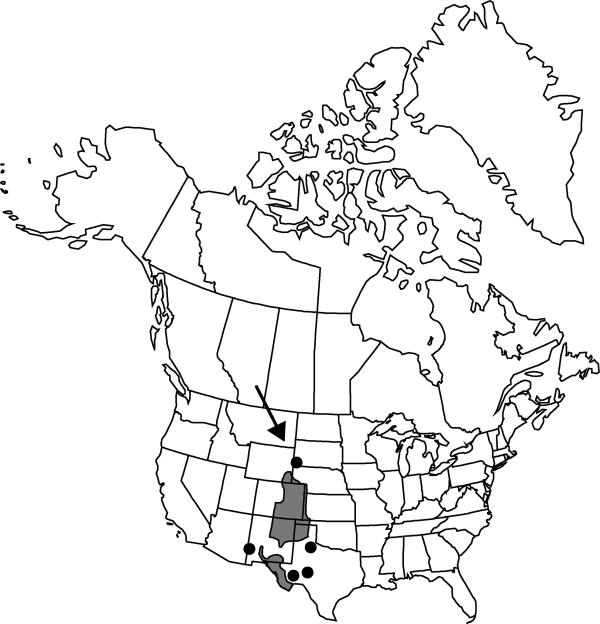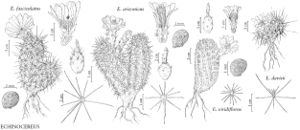Echinocereus viridiflorus
in F. A. Wislizenus, Mem. Tour N. Mexico, 91. 1848.
Plants unbranched or few branched (rarely forming clumps of 12+ branches). Stems erect, spheric to short cylindric, (3–)8–30(–35) × 2.8–9 cm; ribs 10–20, crests prominent, slightly to conspicuously undulate; areoles 3–12 mm apart. Spines (13–)18–30(–55) per areole, stiff (flexible) and straight (or slightly curved), sometimes pectinately arranged, red-and-white, red-and-yellow, yellow-and-white, whitish, yellowish, or purplish, tips often darker; radial spines 12–38(–45) per areole, appressed to spreading, (2–)4–18 mm; central spines 0–17 per areole, spreading to projecting, terete (subulate), 3–5–40 mm. Flowers 2–3.5 × (1–)1.5–3 cm; flower tube (4–)5–12 × 5–15 mm; flower tube hairs 1–2 mm; inner tepals shades of yellow or brown, frequently tending towards yellowish green or brick red (rarely carmine in Davis Mountains populations), often with darker purplish maroon midstripes, 10–25 × 2–4 mm, tips relatively thin and delicate; anthers yellow; nectar chamber 1–2[–3] mm. Fruits yellowish green to dark green, dark purple, or reddish tinged, 6–17 mm, pulp white. 2n = 22.
Phenology: Flowering Mar–Jun; fruiting 2 months after flowering.
Habitat: Chihuahuan Desert, desert scrub, semidesert grasslands, short-grass prairies, oak woodlands, on igneous or novaculite substrates, gravelly or silty alluvium, rarely on limestone
Elevation: 700-2700 m
Distribution

Colo., Kans., Nebr., N.Mex., Okla., S.Dak., Tex., Wyo., Mexico (Chihuahua, Coahuila).
Discussion
A large number of infraspecific taxa have been recognized within Echinocereus viridiflorus, differing in various combinations of flower color, spine color, number and thickness of central spines, and other characters, including floral scent. Populations of E. viridiflorus with the most numerous central spines (five or more per areole), giving the plants a bristly appearance, are often considered a separate species, E. chloranthus. Wherever such taxa are sympatric they intergrade; all are freely interfertile in the greenhouse.
The common morphotype at middle altitudes in Texas and southeastern New Mexico has 0–2(–3) central spines and is called either Echinocereus viridiflorus var. cylindricus (Engelmann) Rümpler or E. chloranthus var. cylindricus (Engelmann) N. P. Taylor. Typical E. viridiflorus (var. viridiflorus), with small stems and relatively pure yellow flowers, extends from central New Mexico and the Texas Panhandle to South Dakota. One of the segregate taxa, Echinocereus chloranthus var. neocapillus D. Weniger, is remarkable for its softly hairy, not sharply spiny, seedlings. Populations of E. viridiflorus from Big Bend National Park, usually with reddish or russet flowers, have been named E. russanthus D. Weniger. Yellow-spined plants may occur at high altitudes. A poorly defined, yellow-spined population near Marathon, Texas, has been named E. viridflorus var. correllii L. D. Benson. Bristly red-spined plants from New Mexico have recently been segregated as E. chloranthus subsp. rhyolithensis W. Blum & Mich. Lange.
Echinocereus viridiflorus in the broad sense may prove paraphyletic with respect to E. davisii, but they are phenologically isolated, with E. davisii flowering earlier and thus appearing reproductively isolated in the wild.
Selected References
None.
